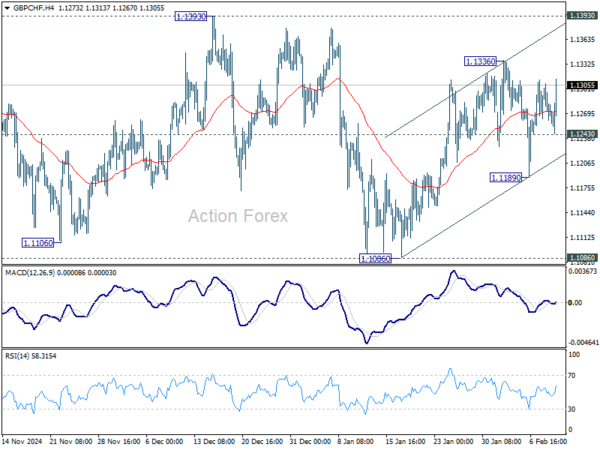Trading is relatively subdued today across global markets as investors assess the fallout from the US steel and aluminum tariffs announced by President Donald Trump. Major European equity indexes are treading water, while US futures are slightly in the red. Treasury yields are recovering, though it remains too early to confirm a reversal of the recent downtrend. Meanwhile, Gold is having a notable pullback after an initial rejection at the key 3000 psychological level, suggesting profit-taking among traders.
European Commission President Ursula von der Leyen responded to the US move, stating that the EU will not let the “unjustified tariffs” go unanswered and pledged “firm and proportionate countermeasures” to protect European interests. However, no specific retaliatory measures have been outlined yet. Canada’s Prime Minister Justin Trudeau also criticized the tariffs as “unacceptable,” reinforcing that “Canadians will stand up strongly and firmly if we need to.” Markets remain cautious, awaiting concrete details on countermeasures from key US trade partners.
At a global level, IMF Managing Director Kristalina Georgieva addressed the uncertainty surrounding the tariff situation at the World Government Summit in Dubai, stating that it remains an “evolving story” and that it is “too early to say” what the full economic impact might be. This reinforces the broader market sentiment that investors are hesitant to make directional bets until more clarity emerges on trade retaliation and its economic implications.
In the forex market, Dollar has turned mixed, losing some momentum against Euro and Sterling while firming up slightly against Yen and Swiss Franc. Market focus is now shifting to Fed Chair Jerome Powell’s Congressional testimony, with investors looking for signals on how long Fed’s current policy pause might last. Powell is also expected to be questioned on the impact of tariffs. Though it is unlikely he will provide any clear forward guidance on both fronts.
GBP/CHF could see increased volatility this week as the UK prepares to release Q4 GDP data and Switzerland reports January CPI figures. The cross has been struggling in range trading since last September. Today’s bounce suggests that rise from 1.1086 is ready to resume through 1.1336 towards 1.1393. Strong resistance could be seen there to limit upside to start another falling leg. Meanwhile, break of 1.1243 should bring deeper fall through 1.1189 towards 1.1086.
In Europe, at the time of writing, FTSE is flat. DAX is up 0.27%. CAC is up 0.16%. UK 10-year yield is up 0.0317 at 4.493. Germany 10-year yield is up 0.051 at 2.416. Earlier in Asia, Japan was on holiday. Hong Kong HSI fell -1.06%. China Shanghai SSE fell -0.12%. Singapore Strait Times fell -0.37%.
US NFIB small business optimism drops as uncertainty rises, hiring challenges persist
NFIB Small Business Optimism Index declined to 102.8 in January, missing market expectations of 104.6 and falling from December’s reading of 105.1.
The decline reflects growing concerns among small business owners, as seven out of the 10 components of the index deteriorated, while only one improved. Additionally, the Uncertainty Index surged 14 points to 100, marking the third-highest reading in its history after two months of easing uncertainty.
NFIB Chief Economist Bill Dunkelberg highlighted while there is still “optimism regarding future business conditions,” uncertainty is climbing. One major concern remains the persistent “hiring challenges,” as businesses struggle to find qualified workers to fill vacancies. Capital investment plans are also being reconsidered.
Australia’s Westpac consumer sentiment ticks up, RBA to start cutting this month
Australia’s Westpac Consumer Sentiment Index rose slightly by 0.1% mom to 92.2 in February. While consumer mood improved significantly in the second half of 2024, the past three months have shown stagnation.
Westpac noted that financial pressures on households persist and a more uncertain global economic climate has also played a role in dampening optimism.
RBA is likely to begin policy easing at its next meeting on February 17–18. Westpac highlighted that recent economic data on core inflation, wage growth, and household consumption indicate that inflation is “returning to target faster” than previously expected.
These factors provide RBA with the confidence to initiate a 25bps rate cut this month, marking the first step in what is expected to be a “moderate” easing cycle through 2025.
Australian NAB business confidence rebounds to 4, but conditions remain weak
Australia’s NAB Business Confidence index made a strong recovery in January, rising from -2 to 4 and returning to positive territory. However, despite this uptick in sentiment, underlying business conditions deteriorated.
Business Conditions index dropped from 6 to 3, marking a notable slowdown. Within this, trading conditions slipped from 10 to 6, while profitability conditions turned negative, falling from 4 to -2. On a more positive note, employment conditions edged up slightly from 4 to 5.
Cost pressures remained a key concern for businesses. Purchase cost growth eased to 1.1% on a quarterly equivalent basis, down from 1.4%. Labor cost growth picked up slightly to 1.8%. Meanwhile, final product price growth held steady at 0.8%, while retail price inflation inched up to 0.9%. Businesses are struggling to fully pass on rising costs to consumers.
NAB Chief Economist Alan Oster noted that while confidence improved, it is uncertain whether this momentum will be sustained. Elevated cost pressures, particularly on wages and input costs, continue to weigh on overall business conditions.
EUR/USD Mid-Day Outlook
Daily Pivots: (S1) 1.0282; (P) 1.0310; (R1) 1.0334; More…
EUR/USD recovers mildly today but stays in the middle of the near term established range above 1.0176. Intraday bias remains neutral for the moment. Outlook will remain bearish as long as 38.2% retracement of 1.1213 to 1.0176 at 1.0572 holds. On the downside, break of 1.0176 will resume whole fall from 1.1213. However, decisive break of 1.0572 will raise the chance of reversal, and target 61.8% retracement at 1.0817.
In the bigger picture, immediate focus is on 61.8 retracement of 0.9534 (2022 low) to 1.1274 (2024 high) at 1.0199. Sustained break there will solidify the case of medium term bearish trend reversal, and pave the way back to 0.9534. However, reversal from 1.0199 will argue that price actions from 1.1274 are merely a corrective pattern, and has already completed.



